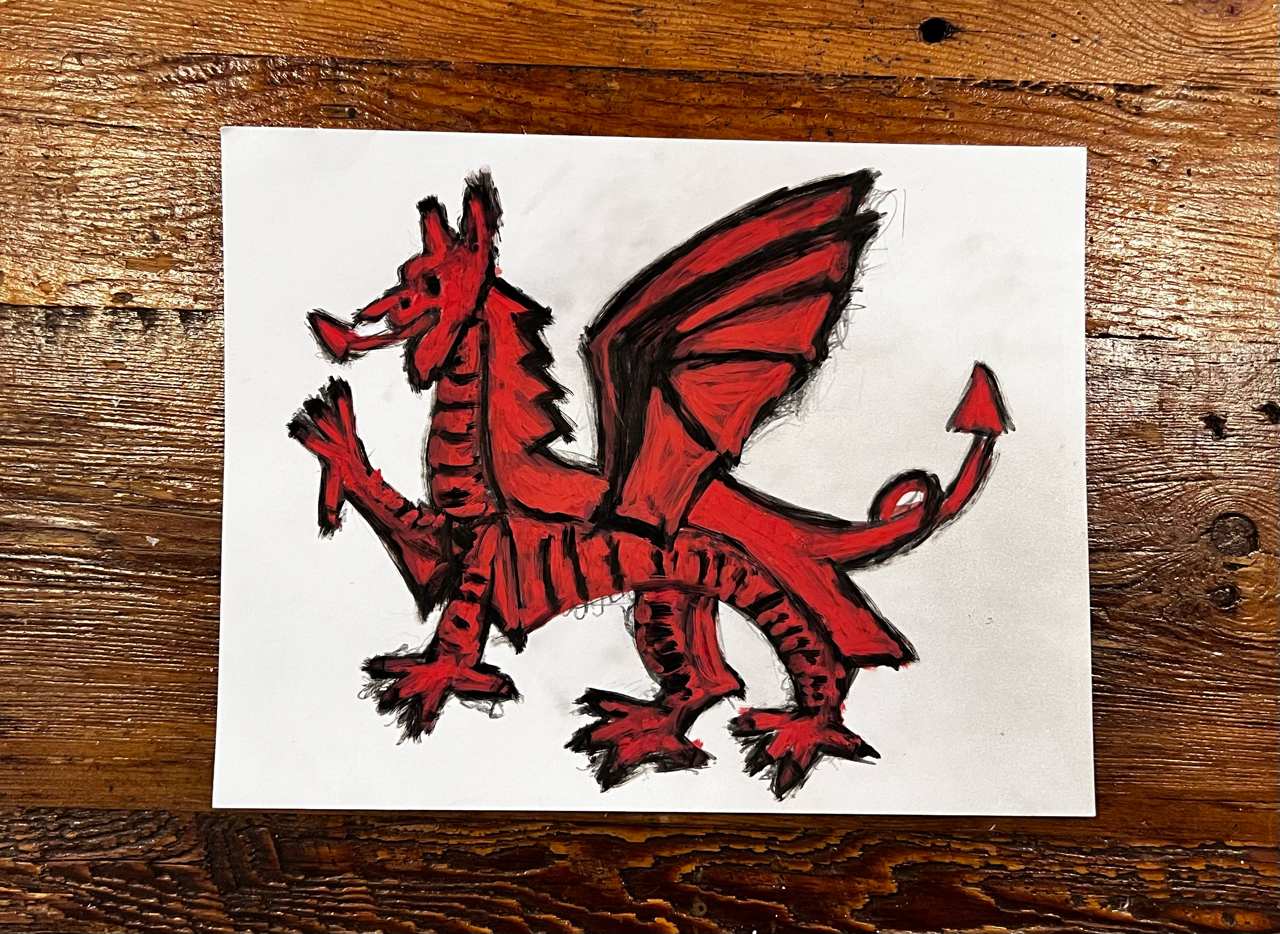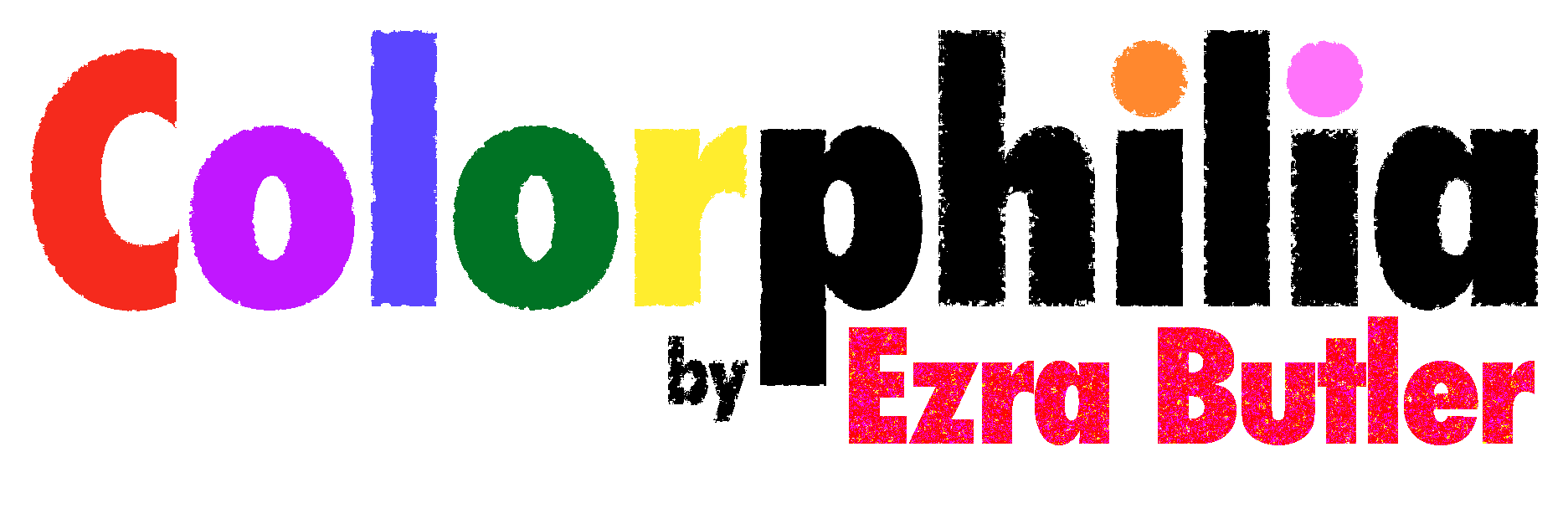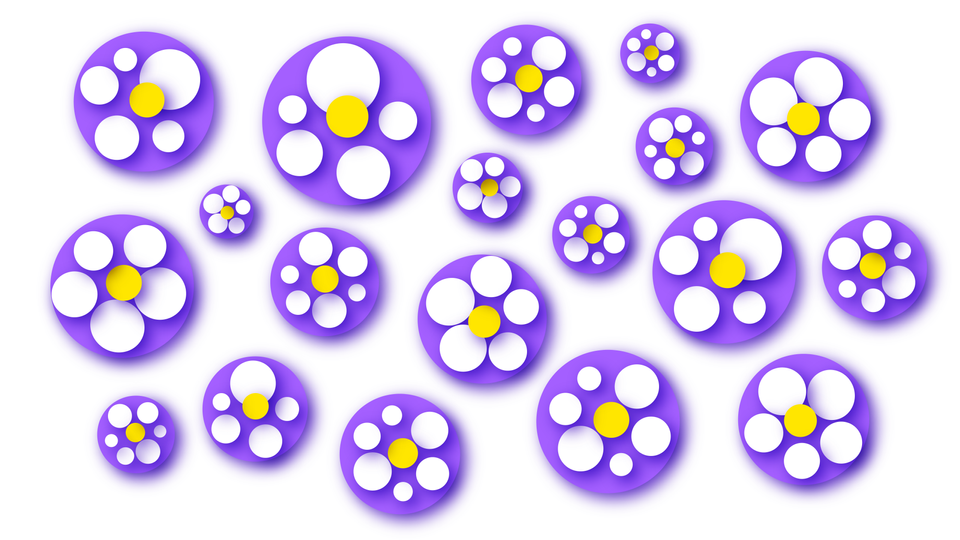Why I Learned Lliwiau (colors) in Cymraeg (Welsh)
Or: A very basic introduction to Welsh color words by someone who doesn't speak the language, yet.

For the past 10 months, I've been researching the etymologies and histories of colors and color-related words in languages ranging from the ancient Near East to medieval and early modern Europe to modern day America.
Roughly a month ago, a Welsh modern linguist named Joshua Morgan sent me a list of twelve colors in Welsh and I took it as a challenge to identify each of their etymologies.
They are gwyrddlas (teal), pinc (pink), brown (brown), melyn (yellow), glas (blue), oren (orange), coch (red), porffor (purple), gwyrdd (green), du (black), llwyd (gray), and gwyn (white). From first sight, I thought knew some of the etymologies, some ended up being correct and some being wrong.
Some of them are not the traditional names for the colors, and because I'm known as a traditionalist in some circles, so in the etymologies below, I've also included the original words they would have been called.
Overview
In this newsletter, I explore dark words in Welsh related to du, understand which sort of words start with GWY- and GL-, and go through the words which begin with the LL- to try to understand how it could be logical for the word for dust to be related to the word for president.
During the LL- section, I also discovered that the word for gray is really synonymous with shade, and thus is connected with both trees and orchards as well as pictures, like we've seen before.
I also find how the history of Welsh orange is similar to the French fruit and Dutch carrots, and how straightforward it would be to describe most any color or shade in pure Welsh.
A History of Being Invaded
Wales is a fascinating country with a very complicated linguistic history. They spoke a language, along with the speakers of Irish, Cumbric, Cornish, and Breton (in France) called Brythonic. The Romans conquered them. Then the Vikings came. Then the Anglo-Saxons. Times were so bad for the Welsh, that their Druid priests were persecuted and forbidden from writing in Welsh. The spoken language had persisted and finally had its first modern dictionary compiled in the 16th century.
When they began writing again, they invented a new genre of literature and the entire world of Brenin Arthur (King Arthur) from early poetry to complete histories. In the 12th century, Geoffrey of Monmouth wrote the extremely popular Historia Regum Britanniae (History of the Kings of Britannia), which from the little I know about history, was one of the main reasons Edward I decided to conquer Wales and steal all of their intellectual property for England.
To make matters even worse, in 1975, Cymru (which is the Welsh name for Wales) was invaded by a rogue comedic troupe from England, pretending to ride on horses made from imported coconuts, attempting to storm their medieval castles. The sheer gall.
The Welsh Language / CYMRAEG
At first glance, Welsh looks like a complex series of consonants, but once you learn a little about the language you can see its beauty and simplicity. All words are built on other words, and by making compound words, like in German and Russian. When they borrowed (read: were forcibly given words from other languages throughout history), they tended to incorporate them into the already existing structure of the language.
In order to identify each word’s etymology, I may have gone a little overboard. I wanted to show words in context, which I feel explains their meaning better than I could ever.
Please note: I used a number of historical dictionaries, in Welsh and a few other languages including, but not limited to, Irish, Cornish, Breton, Icelandic, and Norwegian. Any mistakes are my own.
Also, many words are constructed in different ways. It seems like there isn't just one way to say anything in Welsh, but the same could be said in most languages.
Colors / LLIWIAU
Let’s start with du (black) and gwyn (white).
There are multiple ways to say “liquid or fluid”: The roots of two of them are either dwr or gwy. I’m going to assume that gwy is transparent water and dwr is an opaque liquid.
Black / DU
Du means ink, black and gloomy. Da happens to mean good.
I’ve identified a fascinating pattern in many languages that the lower the vowel, the darker the word.
- duder - darkness
- dudew - a thick black
- dueg - melancholy
- dull - figure or shape (not how you think it would be pronounced and more on this later)
- duo - to blacken
- dur - something hard or steel
This last one is interesting. Think of the word “durable”. This is one of the fascinating things about language. They incorporated the Latin into their language, because “dur” sounded like a logical continuation of “du”.
But even du (meaning black or ink) reminds one of the dyo / dyota for black and ink in Aramaic and Hebrew.
Intro to GWY-
- Gwyn - the color white, light, being blessed, fair and beautiful
- Gwynfyrd - a happy mind
- Gwyr - pure, fresh, verdant
- Gwyrdd - the color green
- Gwyrddon verdant plant.
- Gwryddfaen, emerald or literally “green stone”, in case you were interested.
- Gwyrth - virtuous, precious, miracle
- Gwyryd - purity, chastity
- Gwyryf - a virgin
- Gwyrdd - the color green
In some languages, virginity is associated with white for a number of reasons, but in Welsh, it is associated with green. Out of context, it may be a little puzzling, but in context, it is easy to see the evolution of the word.
Gwyr doesn’t mean “clear”, but “pure” it means “fresh” and “verdant” as in foliage, another positive connotation. Water which is gwyr would not be salt-water, and would be potable.
Note that there is a distinction between “blessed”, “happy”, and “bliss”, which are all white gwyn-related words, and “pure” and “fresh” which are green gwyr-related words. They are not synonymous.
Advanced GWY-
As the suffix changes, we can observe conceptual shifts, from dark to light, from light to purity and water, from potable water and greenery to a country and a people, to the loss of water and withering away.
- gwyll - gloomy, dark
- gwyllon / gwyllion - shades, phantoms, ghosts
- gwym - sleek or glossy
- gwyn - white, clear
- gwynt - wind, odor, or scent
- gwyr - pure, fresh (without salt)
- gwyrdd - green
- gwys - a people, a country | knowledge (different root)
- gwyth - a channel, gutter or drain | wrath, indignation (different root)
- gwyw - withered or faded (lacking water)
Shades of Gray / LLWYD
Why is gray llwyd? Good question. First of all, LL is pronounced something like the Spanish LL (lluvia). So it is pronounced something like shuid.
Each of the base word beginnings has a different meaning which somehow flows through all the descendants. From the flow of the roots, a story can be seen. From the expansive and the everywhere, to the specific location, to the consistent connected stream, to being cut off, to moving, to being sent out positively, to continuing.
LLA - light or clear
LLE - location or place
LLI - flow or stream
LLO - thrown out or ejected
LLU - things in motion
LLW - something moved, sent or brought forward
LLY - a continuum, things which extends out, the ability to proceed
From the root, other letters and words are added on to extend the meanings.
For example:
- lliw - color
- lliwlas (lliw [color] + glas [blue]) - a blue color (but not the normal way to say blue)
- lliwiau - colors
From Dust (LLWCH) to President (LLYWYDD)
While this is not strictly in order, each progression and words built up make sense. While it may seem to be reaching, we have to remember that language progresses piece by piece. Again, this isn’t simply about light to dark, it’s about the whole, the parts of the whole, and their relationship to the whole.
Gray and shade are always in the median. They are not connected, nor fully separate. They are not light, nor are they dark. They are not covered, nor exposed.
Shade is a word that is related to duplication. Drawing is all about using shade to recreate reality. In Hebrew, musical notes and echoes are similarly related. Duplication is not disconnection, there is always a connection back to the source.
Please note that you can click to skip to the next section –
- llwb - something that bulges out
- llwd - something that is cast or ejected
- llwdn - a birthing, like the foal of an animal
- llwch - dust (which are parts of the ground which break off)
- llwg - bright or livid
- llygad - the eye, or eyesight
- llygas - light, shining
- llygaw - to cast a splendor
- llygawl - to brighten
- llygorn - a lamp
- llygu - to make bright, to clear
- llug - a gleam of light
- llugan - something that glitters
- llym - sharp, keen
- llwm - bare, naked or exposed
- llwn - a part of something
- llŷn - something that flows out (liquid)
- llynw - a collection of liquid
- llyst - a vessel for holding liquor
- llws - something that separates
- llysu - to reject, to separate from
- llwt - something which is thrown
- llwy - something that reaches out
- llwyd - the diffusion of the light and dark, which makes gray. It’s like shade, which is at the same time connected, but isn’t. Like we saw in A Brief History of Shade, forms and other words can be built off shade.
- llwyf - a form or frame, or an elm tree, like something which casts a shadow,
- llwyn - a grove, woods, or a shaded area which is a collection of trees.
- llun - a picture or an image.
- llur - a gloom or something pale
- llwyr - complete or including all
- llwys - clean, holy, or pure
- llys - a place that separates, a palace, or a court
- llwyth - a tribe or a nation
- llywy - superior or paragon
- llywydd - a president
- llywych - reflection of light, color
Quick GL- Overview
GL-, like in other languages, has a meaning of “liquid shining”, like “glittering” and “gleaming” or even with the lack of reflection like “gloom” or “glum”. Adding “-las” to words changes the hue to blue, green, and gray, like the color of water. I believe that it has to do with LLA being related to clarity. Glas ultimately became solely blue.
- glai - glistening
- glain or glan - pure, clean, and holy
- glas - blue
- glo - coal (remember that coal glows)
- gloew - bright and transparent glow
Now that we know a few different colors, we can combine colors: teal is gwryddlas, or literally green-blue.
Yellow / MELYN
Another borrowed word seems to be the word for yellow. Melyn is not yellow because of the fruit melon, but because mel is the Latin word for honey, which is golden or yellow. Melys means sweet.
Red / COCH / RHUDD
There are two main ways to say red, coch (like loch), and rhudd, although it seems the dominant one now is coch.
The word rhudd is which is probably connected to the word for earth (like dirt), but that is a piece for another time.
We may have spoken before about the dye from the cochineal bug which was used to create the scarlet color, similar to the Kermes. Coch is not taken from the name of the bug, which was only named around the 16th century. It likely came over through trade with the Greeks (or the Romans), and comes from the Greek word κόκκος , just like the Latin.
It is impossible to know for certain. Because the written language was lost for so long, many of the spellings in Welsh are more phonetic. So coch at times was written as koch or even goch.
There was also individuals from the 6th century on with the name Goch or Gawch, including Owain Goch ap Gruffydd (Owain the Red), prince of Gwynedd, whose father died escaping from the Tower of London in 1244. There was also Cynlas Goch in the 6th century, who was called Cuneglasus in Latin, who was a tyrant whose name was loosely translated as a “amber-colored butcher”, as an epithet, by Gildas the Wise in De Excidio et Conquestu Britanniae (on the Ruin and Conquest of Britain). I’m assuming that the name was likely to describe his ruddy features or red hair, and the epithet was describe the blood on his hands and apron.
Y Ddraig Goch, or the (Welsh) Red Dragon is heraldic symbol of Wales. Ddraig was a word that referred to leaders, but also dragons. Fun fact: Wales is the only place where you can find a synagogue with a red dragon protecting it. Geoffrey of Monmouth also used a red dragon for a prophecy about King Arthur.
Other Colors
Porffor (purple) is also from the Greek purpura, originally connected with pryffwn or superiority. The color has also been described as was described as glasgoch (blue-red) or rhuddlesni (from rhuddglas (red-blue).
Pinc (Pink) used to be rhuddgoch (red-scarlet). Brown used to be gwrm, dulwyd, and many, many other words.
Oren is a modern term, probably evolved from Eurin (golden). It used to be melyngoch (yellow-red). They referred to the orange as a eurfal (aur-afal) or golden apple, and likely would refer to shiny orange things as euraid (golden).
Final Thoughts
I ended up thinking a lot about the English language and tonality and root words and phrases. What does PL- mean at the beginning of a word like "place", "play", or "plot"? Is there some relation between the vowels in words like "fall" and "full", and "cross" and "crass", or in the final consonants of "grip" and "grim"?
Even in the Welsh, I wondered if gwyn (white) was similar to the h-w-r white words I researched in Hebrew and Aramaic. Maybe the phoneme of GW- represents a version of the ḥeth. Older Welsh dictionaries seem to try to find connections with Hebrew words, but I didn't find their arguments very satisfying, but maybe that's because I actually speak that language.
The more I studied Welsh and the other Brythonic languages, the more I thought about the forced syncretism of cultures, but also how they attempted to keep their languages pure. I learned about their attempts to revitalize the languages and teach them to the new generations.
I learned how much I didn't know about another persecuted people. I also didn't know how a town in Wales banned Monty Python's Life of Brian because of the apparent blasphemy, and that the Welsh actress in it, Sue Jones-Davis, became the mayor of Aberystwyth, I'm assuming for the sole purpose of removing the ban.




